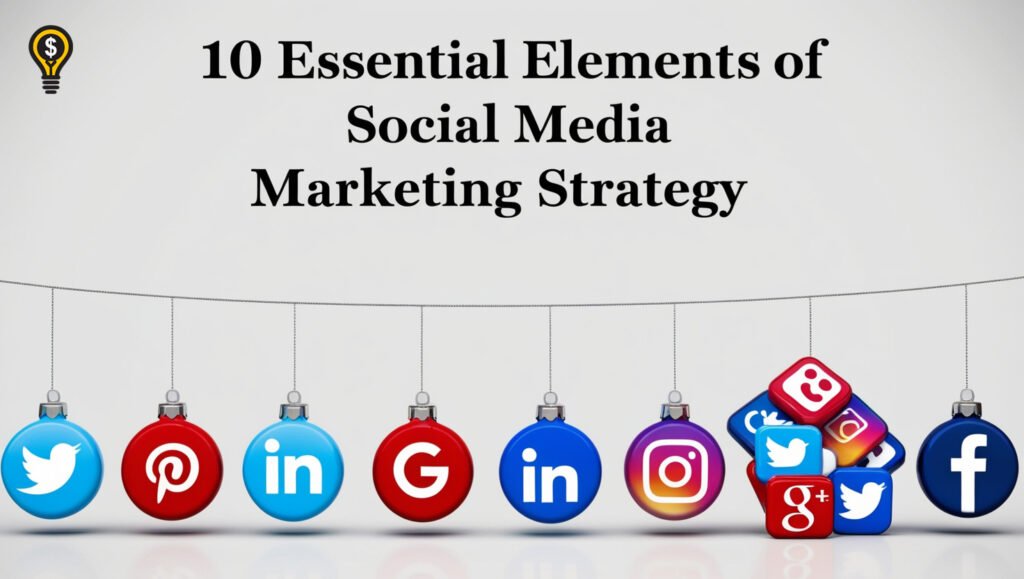
Introduction to Social Media Marketing
Social media marketing is essential for businesses today. It helps you connect with your audience, build your brand, and drive sales. If you’re looking to grow your business, understanding social media is key. You can reach potential customers where they spend their time—online.
In this article, we’ll explore the benefits of social media marketing and the strategies you need to succeed. You’ll learn about the key elements of a solid strategy and how to measure your success. Whether you’re new to social media or want to improve your efforts, this guide will help you take the next step. Let’s dive in!
2. Benefits of Social Media Marketing
Social media marketing offers numerous advantages that can transform your business. Here are some key benefits you should consider:
1. Increased Brand Awareness
Social media platforms provide a vast audience. By creating engaging content, you can reach more people and make your brand recognizable. Each share, like, or comment increases your visibility. You can connect with potential customers who may not have discovered you otherwise.
2. Improved Customer Engagement
Social media allows you to interact directly with your audience. You can respond to comments, answer questions, and gather feedback. This interaction builds trust and loyalty. When customers feel heard, they are more likely to choose your brand again.
3. Cost-Effective Marketing
Compared to traditional advertising, social media marketing is often more affordable. You can create posts, videos, and ads at a fraction of the cost. Even small businesses can compete with larger companies. This makes it easier for you to reach your target market without breaking the bank.
4. Targeted Advertising
Social media platforms offer advanced targeting options. You can reach specific demographics based on age, location, interests, and behaviours. This means your ads are seen by the people most likely to be interested in your products or services. You can spend your budget more effectively, increasing your return on investment.
5. Valuable Insights and Analytics
Most social media platforms provide tools to analyse your performance. You can track engagement, reach, and conversions. This data helps you understand what works and what doesn’t. You can adjust your strategy based on real-time feedback, making your efforts more effective.
6. Drive Website Traffic
Social media can drive significant traffic to your website. By sharing links to your blog posts, product pages, or promotions, you can guide users directly to your site. More visitors can lead to higher conversion rates, turning casual browsers into paying customers.
7. Enhanced Brand Loyalty
Engaging consistently with your audience helps build loyalty. When customers feel a connection with your brand, they are more likely to stick around. You can create a community where customers share experiences and advocate for your business.
8. Access to Industry Trends
Social media keeps you connected with your industry. By following relevant pages and influencers, you can stay updated on trends and news. This knowledge helps you adapt your strategy and stay competitive.
Social media marketing can significantly benefit your business. From increased visibility to better customer engagement, the advantages are clear. As you explore this article further, you’ll discover how to leverage these benefits to achieve your business goals.
3. Essential Elements of a Social Media Strategy

Creating an effective social media strategy is crucial for your success. Here are the key elements you need to consider:
1. Define Your Goals
Start by identifying what you want to achieve. Your goals could include increasing brand awareness, generating leads, driving website traffic, or boosting sales. Clear objectives will guide your strategy and help you measure success.
2. Know Your Audience
Understanding your target audience is vital. Create buyer personas to define who they are, including their demographics, interests, and behaviours. This knowledge allows you to tailor your content and messaging, making it more relevant and engaging.
3. Choose the Right Platforms
Not all social media platforms are suitable for every business. Research which platforms your audience uses most. For example, if you’re targeting younger consumers, platforms like TikTok or Instagram may be more effective. Focus your efforts on the platforms that align with your audience and goals.
4. Develop a Content Plan
A content plan outlines what you will post and when. This should include a mix of content types, such as images, videos, blog links, and user-generated content. Plan for different formats to keep your audience engaged. Consistency is key; aim to post regularly to maintain visibility.
5. Create Engaging Content
High-quality, engaging content is essential for capturing attention. Use visuals, catchy headlines, and strong calls to action. Your content should resonate with your audience’s interests and encourage interaction. Don’t be afraid to experiment with different styles to see what works best.
6. Schedule Your Posts
Using a social media scheduling tool can help you manage your posting times. Consistent timing can increase engagement. Analyse when your audience is most active to determine the best times to post. This way, your content reaches more people when they are online.
7. Monitor and Engage
Social media is not just about posting content; it’s about building relationships. Regularly check your accounts for comments and messages. Respond promptly to engage with your audience. This two-way communication fosters trust and loyalty.
8. Analyse Performance
Utilise analytics tools to track your performance. Monitor metrics such as engagement rates, click-through rates, and conversions. This data provides insights into what’s working and what isn’t. Use these insights to adjust your strategy as needed.
9. Stay Updated on Trends
Social media is constantly evolving. Keep an eye on new features, trends, and algorithm changes. Adapt your strategy to stay relevant and make the most of emerging opportunities. Following industry news and best practices can keep you ahead of the competition.
10. Budget for Paid Advertising
Consider incorporating paid advertising into your strategy. Set a budget for social media ads to extend your reach and target specific audiences. Paid ads can complement your organic efforts and drive significant results.
a well-rounded social media strategy encompasses clear goals, audience understanding, engaging content, and ongoing analysis. By focusing on these essential elements, you can create a robust plan that drives success for your business. As you continue, you’ll learn how to measure your efforts and refine your approach for even better results.
4. Understanding Social Media Metrics

To succeed in social media marketing, you must track and analyse your performance through metrics. These numbers provide insights into how well your strategy is working and where improvements can be made. Here are the key metrics to focus on:
1. Engagement Rate
Engagement rate measures how well your audience interacts with your content. It includes likes, shares, comments, and saves. A high engagement rate indicates that your audience finds your content valuable and is willing to interact with it. To calculate the engagement rate, divide the total engagement (likes, comments, shares) by your total followers, then multiply by 100 to get a percentage.
2. Reach and Impressions
- Reach refers to the total number of unique users who see your content. It helps you understand how many people are exposed to your brand.
- Impressions measure the total number of times your content is displayed, regardless of whether it was clicked or not. While reach gives you a sense of audience size, impressions show how often your content is seen.
Both metrics are crucial for understanding brand visibility and the effectiveness of your posts.
3. Click-Through Rate (CTR)
CTR measures how often people click on links in your posts compared to how many times the posts were viewed. A high CTR indicates that your content is compelling and encourages users to take action. To calculate CTR, divide the number of clicks by the number of impressions and multiply by 100.
4. Follower Growth Rate
Tracking how quickly your follower count is growing can provide insights into your brand’s popularity and reach. A consistent increase in followers indicates that your content resonates with your audience. To calculate the growth rate, take the number of new followers gained during a specific period, divide it by the total followers at the beginning of that period, and multiply by 100.
5. Conversion Rate
The conversion rate tells you how many users completed a desired action after engaging with your content. This could be signing up for a newsletter, making a purchase, or filling out a contact form. To calculate the conversion rate, divide the number of conversions by the total visitors from your social media efforts, and multiply by 100. This metric is crucial for understanding the effectiveness of your sales funnel.
6. Share of Voice
Share of voice measures your brand’s presence compared to competitors. It helps you understand how much of the conversation around your industry includes your brand. You can track mentions of your brand across social media platforms and compare them to your competitors. A higher share of voice indicates a stronger position in your market.
7. Audience Demographics
Understanding the demographics of your audience can help you tailor your content and advertising strategies. Most social media platforms provide insights into the age, gender, location, and interests of your followers. Use this data to create content that resonates with your target audience.
8. Customer Sentiment
Monitoring customer sentiment involves analysing how your audience feels about your brand based on their interactions. Positive comments, shares, and mentions indicate a favourable perception, while negative feedback may highlight areas needing improvement. Tools that analyse sentiment can help you gauge public opinion and make necessary adjustments.
9. Return on Investment (ROI)
Calculating ROI is essential for understanding the financial effectiveness of your social media efforts. To calculate ROI, subtract the total costs of your social media marketing from the total revenue generated from those efforts, then divide by the costs and multiply by 100. A positive ROI indicates that your social media strategy is paying off.
10. Content Performance
Finally, analysing which types of content perform best is crucial for optimising your strategy. Review the engagement, reach, and conversion rates for different posts to determine what resonates most with your audience. This analysis helps you refine your content plan and focus on what works.
Understanding social media metrics is key to improving your marketing efforts. By tracking these metrics, you can gain valuable insights, make informed decisions, and optimise your strategy for better results. As you move forward, you’ll be better equipped to analyse your performance and drive success in your social media marketing initiatives.
5. Audience Insights and Targeting

Understanding your audience is crucial for effective social media marketing. By gathering insights about who your customers are and how they behave, you can create tailored content and campaigns that resonate with them. Here’s how to gain audience insights and effectively target your marketing efforts:
1. Conduct Market Research
Start with thorough market research to understand your industry and competitors. Analyse trends, demographics, and consumer behaviour. Surveys, focus groups, and online research can provide valuable data. This information lays the groundwork for creating buyer personas.
2. Create Buyer Personas
Buyer personas are semi-fictional representations of your ideal customers. They include demographic information (age, gender, location), interests, and pain points. By developing detailed personas, you can tailor your content and messaging to meet their specific needs. Consider creating multiple personas to represent different segments of your audience.
3. Analyze Existing Data
Use analytics tools from social media platforms to gather insights about your current followers. Most platforms provide demographic data, such as age, gender, location, and interests. This information helps you understand who is engaging with your content and allows you to refine your targeting.
4. Monitor Engagement Patterns
Pay attention to how your audience engages with your content. Analyse which posts receive the most likes, comments, and shares. Look for patterns in the type of content that resonates—whether it’s videos, infographics, or articles. Understanding these preferences will guide your future content creation.
5. Utilise Social Listening
Social listening involves monitoring social media channels for mentions of your brand, competitors, and relevant industry topics. Tools like Hootsuite and Sprout Social can help you track conversations and sentiment around your brand. This information can uncover customer opinions, preferences, and emerging trends that you can leverage in your marketing.
6. Leverage Audience Segmentation
Segment your audience based on various criteria, such as demographics, behaviours, and interests. This allows you to create targeted campaigns for specific groups. For instance, you can tailor content for new customers versus loyal ones or for different geographic locations. Segmentation helps ensure that your messaging is relevant and engaging.
7. Experiment with A/B Testing
A/B testing involves creating two versions of a post or ad to see which performs better. Test different headlines, images, or calls to action to determine what resonates most with your audience. By analysing the results, you can refine your strategy and optimise your content for maximum engagement.
8. Personalise Your Content
Once you have insights about your audience, use that information to personalise your content. Tailor messages to address specific pain points or interests of different audience segments. Personalised content often leads to higher engagement and conversion rates, as it feels more relevant to the reader.
9. Stay Updated on Audience Trends
Audience preferences can change over time. Regularly review your analytics and social listening data to stay informed about shifting trends and interests. Adapting to these changes will help you maintain relevance and strengthen your connection with your audience.
10. Engage Directly with Your Audience
Encourage interaction by asking questions, conducting polls, and hosting Q&A sessions. Engaging directly with your audience not only provides insights but also fosters a sense of community. Use feedback from these interactions to further refine your targeting and content strategy.
gaining audience insights and effectively targeting your marketing efforts are vital for successful social media campaigns. By understanding who your customers are and how they behave, you can create tailored content that resonates with them. This targeted approach will enhance engagement, increase brand loyalty, and ultimately drive better results for your business. As you implement these strategies, you’ll find it easier to connect with your audience and achieve your marketing goals.
6. Creating Engaging Content

Creating engaging content is crucial for capturing your audience’s attention on social media. It not only helps build brand awareness but also fosters interaction and loyalty. Here are key strategies to ensure your content resonates with your audience:
1. Know Your Audience’s Preferences
Understanding your audience is the first step in creating engaging content. Use insights from previous posts and analytics to determine what types of content your audience enjoys. Are they more responsive to videos, images, or written posts? Tailor your content to meet their preferences.
2. Use High-Quality Visuals
Visual content is more likely to grab attention than text alone. Invest in high-quality images, infographics, and videos that reflect your brand’s identity. Tools like Canva or Adobe Spark can help you create stunning visuals, even if you don’t have design skills. Engaging visuals make your posts more shareable and memorable.
3. Craft Compelling Headlines
Your headlines are the first thing people see, so make them count. Use clear, catchy, and informative headlines that spark curiosity. Consider using numbers, questions, or strong action words to draw readers in. A great headline can significantly increase click-through rates.
4. Tell a Story
Storytelling can make your content more relatable and impactful. Share personal experiences, customer success stories, or brand history. People connect with stories on an emotional level, which can strengthen their bond with your brand. Ensure your narratives align with your brand values and resonate with your audience.
5. Incorporate User-Generated Content
User-generated content (UGC) is content created by your customers, such as reviews, testimonials, or photos. Sharing UGC not only provides social proof but also encourages community engagement. Encourage your audience to share their experiences with your brand and showcase their content on your platforms.
6. Include Clear Calls to Action (CTAs)
Every piece of content should have a clear purpose. Include strong CTAs that guide your audience on what to do next—whether it’s visiting your website, signing up for a newsletter, or making a purchase. Use action-oriented language and make it easy for your audience to take the next step.
7. Experiment with Different Formats
Don’t stick to just one type of content. Experiment with various formats to see what resonates best with your audience. Consider videos, polls, quizzes, live streams, or carousel posts. Variety keeps your content fresh and engaging, encouraging more interaction.
8. Stay Relevant with Trending Topics
Monitor trending topics and current events relevant to your audience. Creating timely content that relates to popular discussions can increase your visibility and engagement. Use relevant hashtags to broaden your reach and connect with users interested in those topics.
9. Foster Conversations
Encourage discussions within your posts by asking open-ended questions. This invites your audience to share their opinions and experiences, creating a sense of community. Responding to comments and engaging in conversations can enhance relationships and build loyalty.
10. Analyse and Iterate
Regularly review your content performance metrics to understand what works and what doesn’t. Look at engagement rates, shares, and comments to gauge interest. Use these insights to refine your content strategy. Continually experimenting and adapting will keep your content engaging and relevant.
Creating engaging content is about knowing your audience, using high-quality visuals, and telling compelling stories. By incorporating diverse formats and encouraging interaction, you can enhance engagement and build a loyal community. As you implement these strategies, you’ll see how impactful engaging content can be for your social media marketing efforts.
7. Building an Evergreen Content Library

An evergreen content library is a valuable asset for any social media marketing strategy. This type of content remains relevant and useful over time, allowing you to consistently engage your audience without needing to create new material constantly. Here’s how to build and maintain an effective evergreen content library:
1. Identify Evergreen Topics
Start by identifying topics that will remain relevant regardless of trends or seasons. These could include how-to guides, FAQs, tips, and foundational knowledge related to your industry. Consider your audience’s ongoing needs and interests when selecting these topics. For example, if you run a fitness business, evergreen topics might include “Beginner’s Guide to Exercise” or “Healthy Eating Tips.”
2. Create High-Quality Content
Focus on creating high-quality, in-depth content for your evergreen pieces. This could involve comprehensive articles, informative videos, or detailed infographics. Ensure that your content is well-researched and provides real value to your audience. The better the quality, the more likely it will be shared and referenced over time.
3. Optimise for SEO
Optimise your evergreen content for search engines to increase its visibility. Use relevant keywords that your audience is likely to search for. This includes optimising titles, headings, meta descriptions, and image alt text. Good SEO practices will help your content rank higher in search results, driving organic traffic to your site.
4. Promote on Social Media
Once you’ve created evergreen content, promote it across your social media platforms. Share it periodically to reach different segments of your audience. Use engaging visuals and strong CTAs to encourage clicks. You can also create teaser posts that highlight key points to draw people in.
5. Repurpose Content
Repurpose your evergreen content into different formats to extend its reach. For instance, you can turn a blog post into an infographic, a video, or a podcast episode. This allows you to reach audiences who prefer different content types while maximising the value of your original piece.
6. Create a Content Calendar
Establish a content calendar to schedule the regular promotion of your evergreen content. This ensures that you continually share it over time without overwhelming your audience. Consider seasonal promotions or relevant events where you can highlight specific pieces of content.
7. Monitor Performance
Regularly analyse the performance of your evergreen content. Look at metrics such as traffic, engagement, shares, and conversions. This data will help you understand which pieces resonate most with your audience. Use this information to refine your content strategy and create more of what works.
8. Update and Refresh
While evergreen content is designed to remain relevant, it’s essential to revisit and update it periodically. Ensure the information is current, accurate, and reflects any changes in your industry. Refreshing your content keeps it valuable and relevant for your audience, preventing it from becoming outdated.
9. Encourage User Interaction
Incorporate elements that encourage user interaction, such as comment sections or questions at the end of your posts. This engagement can provide insights into your audience’s thoughts and preferences, which can inform future content creation.
10. Build a Resource Hub
Consider creating a dedicated section on your website for evergreen content. This resource hub can serve as a go-to place for users seeking valuable information. Organise the content by categories or topics for easy navigation, making it user-friendly and accessible.
building an evergreen content library is an effective way to provide ongoing value to your audience. By focusing on high-quality, relevant topics and optimising for SEO, you can create content that consistently attracts and engages users. Regularly promoting, updating, and repurposing this content will help you maintain its relevance and effectiveness in your social media marketing strategy. As you develop your library, you’ll find that it becomes a powerful resource for both your audience and your business.
8. Leveraging Influencer Marketing

Influencer marketing is a powerful strategy for amplifying your brand’s reach and credibility on social media. By collaborating with individuals who have a strong following and influence within your niche, you can connect with a broader audience and enhance your marketing efforts. Here’s how to effectively leverage influencer marketing:
1. Identify the Right Influencers
The first step in leveraging influencer marketing is to identify influencers who align with your brand values and target audience. Look for individuals whose content resonates with your niche. Consider factors like engagement rates, follower demographics, and the authenticity of their interactions. Tools like BuzzSumo or HypeAuditor can help you find and analyse potential influencers.
2. Define Your Goals
Before reaching out to influencers, clearly define your marketing goals. Are you aiming to increase brand awareness, drive traffic to your website, or boost sales? Setting specific objectives will guide your influencer selection and campaign strategy. For example, if your goal is to increase awareness, look for influencers with a larger following.
3. Create a Collaborative Approach
When approaching influencers, focus on building a collaborative relationship rather than a transactional one. Share your brand story, values, and vision. Discuss how you can work together to create authentic content that resonates with both their audience and yours. Influencers are more likely to engage positively when they feel genuinely connected to your brand.
4. Develop Clear Campaign Guidelines
Once you’ve established a partnership, create clear guidelines for the campaign. Outline expectations regarding content types, posting schedules, messaging, and hashtags. However, allow influencers the creative freedom to express your brand in their own style. Authenticity is key in influencer marketing; their followers appreciate genuine content.
5. Leverage Multiple Platforms
Consider leveraging influencers across multiple social media platforms. Depending on your audience, some influencers may be more effective on Instagram, while others shine on TikTok or YouTube. Tailoring your influencer strategy to specific platforms will maximise your reach and engagement.
6. Utilise Micro-Influencers
While big-name influencers can provide broad visibility, micro-influencers—those with smaller but highly engaged audiences—can offer great value. They often have a more personal connection with their followers, leading to higher engagement rates. Collaborating with several micro-influencers can help you reach niche audiences effectively.
7. Track Campaign Performance
Establish metrics to measure the success of your influencer campaigns. Key performance indicators (KPIs) may include engagement rates, website traffic, conversion rates, and return on investment (ROI). Use tools like Google Analytics, social media insights, and tracking links to gather data. This analysis will help you refine future influencer partnerships and strategies.
8. Encourage Authentic Content
Encourage influencers to create content that feels natural to their audience. Authentic reviews, unboxing videos, or personal stories about using your product are more likely to resonate. The more genuine the content, the more effective it will be in building trust and driving engagement.
9. Build Long-Term Relationships
Aim to cultivate long-term relationships with influencers rather than one-off collaborations. Building ongoing partnerships can lead to more authentic promotion and a deeper connection between your brand and the influencer’s audience. Consistent collaborations can also enhance brand loyalty and recognition over time.
10. Monitor and Adapt
Stay informed about trends and changes in influencer marketing. Regularly assess the effectiveness of your campaigns and be willing to adapt your strategies. Social media landscapes change rapidly, so being flexible and open to new approaches will keep your influencer marketing efforts relevant and impactful.
leveraging influencer marketing can significantly enhance your social media strategy. By identifying the right influencers, setting clear goals, and fostering authentic partnerships, you can effectively connect with new audiences and build brand trust. As you implement these strategies, you’ll find that influencer marketing can be a powerful tool in driving engagement and achieving your marketing objectives.
9. Measuring Success and Analyzing Metrics

Measuring success and analysing metrics are vital components of any social media marketing strategy. By understanding how your campaigns perform, you can make informed decisions to optimise future efforts. Here’s how to effectively measure success and analyse your metrics:
1. Define Key Performance Indicators (KPIs)
Start by defining the KPIs that align with your marketing goals. Common KPIs include:
- Engagement Rate: Measures likes, shares, comments, and overall interaction with your posts.
- Reach and Impressions: Track how many people see your content and how often it appears in feeds.
- Conversion Rate: Evaluates the percentage of users who take a desired action, such as signing up for a newsletter or making a purchase.
- Click-Through Rate (CTR): Indicates how many people clicked on a link in your post compared to how many saw it.
Selecting relevant KPIs will provide clear indicators of your campaign’s performance.
2. Utilise Analytics Tools
Most social media platforms come with built-in analytics tools that provide insights into your performance. Use these tools to track your KPIs:
- Facebook Insights: Offers data on page performance, post engagement, and audience demographics.
- Instagram Insights: Provides metrics on follower growth, post interactions, and reach.
- Twitter Analytics: Shows engagement rates, impressions, and follower demographics.
Third-party tools like Hootsuite, Sprout Social, or Google Analytics can also offer more comprehensive insights across platforms.
3. Monitor Engagement Metrics
Engagement metrics are essential for assessing how your audience interacts with your content. Focus on:
- Likes and Shares: Indicate how well your content resonates with your audience.
- Comments: Provide qualitative feedback and insights into audience sentiments.
- Saves and Retweets: Show how valuable your content is to your audience, encouraging them to revisit or share it.
Regularly analysing these metrics helps you understand what types of content drive engagement.
4. Track Audience Growth
Monitor your follower growth over time. A steady increase in followers indicates that your content is appealing and your brand is gaining traction. Pay attention to spikes or drops in follower counts, which may correlate with specific campaigns or content types.
5. Assess Content Performance
Evaluate which specific posts or types of content perform best. Look for patterns in high-performing content to inform future strategies. Consider factors such as:
- Content Type: Are videos or images more engaging than text posts?
- Posting Time: Do your posts perform better at certain times of the day or week?
- Topics: Identify which subjects generate the most interest and engagement.
6. Calculate Return on Investment (ROI)
Understanding the ROI of your social media campaigns is crucial for justifying your marketing budget. Calculate ROI by comparing the revenue generated from your campaigns against the costs involved. The formula is:
ROI=Net ProfitCost of Investment×100\text{ROI} = \frac{\text{Net Profit}}{\text{Cost of Investment}} \times 100 ROI=Cost of InvestmentNet Profit×100
This will give you a percentage that reflects the profitability of your efforts.
7. Gather Qualitative Feedback
In addition to quantitative metrics, gather qualitative feedback from your audience. Conduct surveys, polls, or focus groups to understand their perceptions of your brand and content. This feedback can provide deeper insights into customer satisfaction and areas for improvement.
8. Use A/B Testing
A/B testing allows you to compare two versions of a post or ad to see which performs better. Experiment with different headlines, images, calls to action, or posting times. Analysing the results can help refine your content strategy and optimise future campaigns.
9. Create Regular Reports
Develop a schedule for reviewing your metrics and creating reports. Monthly or quarterly reports can help you track progress over time and identify trends. Include insights, conclusions, and recommendations for future strategies based on your analysis.
10. Adapt and Optimise
Use your insights to adapt and optimise your social media strategy. If certain types of content perform well, create more of it. Conversely, if something isn’t working, reassess and pivot your approach. Continuous improvement based on data will enhance your effectiveness in reaching your goals.
Success and analysing metrics is essential for maximising your social media marketing efforts. By defining KPIs, utilising analytics tools, and gathering both quantitative and qualitative feedback, you can gain valuable insights into your campaigns. Regularly assessing your performance and being willing to adapt your strategies will ensure your social media marketing remains effective and impactful over time.
10. Staying Updated with Trends

In the fast-paced world of social media marketing, staying updated with the latest trends is crucial for maintaining relevance and engaging your audience effectively. Social media platforms and user behaviours evolve quickly, and keeping up with these changes can give you a competitive edge. Here’s how to stay informed about trends and incorporate them into your marketing strategy:
1. Follow Industry News Sources
Regularly read industry blogs, news websites, and publications focused on social media marketing. Websites like Social Media Examiner, HubSpot, and Buffer provide valuable insights and updates on emerging trends, algorithm changes, and best practices. Subscribing to newsletters can also help you receive curated content directly to your inbox.
2. Engage with Social Media Communities
Participate in online communities and forums dedicated to social media marketing. Platforms like LinkedIn groups, Reddit, and Facebook groups allow you to connect with other marketers, share experiences, and discuss the latest trends. Engaging in conversations can help you gain new perspectives and learn from others in the industry.
3. Monitor Competitors
Keep an eye on your competitors and analyse their social media strategies. Observe their content types, posting frequency, and engagement tactics. Tools like SEMrush or SimilarWeb can help you track their performance. Understanding what works for others in your niche can inspire your own strategies and highlight areas for improvement.
4. Use Trend-Tracking Tools
Leverage trend-tracking tools to stay ahead of the curve. Google Trends allows you to see what topics are currently popular, while BuzzSumo helps you identify trending content and influencers in your industry. These tools can guide your content creation and help you align with what’s resonating with audiences.
5. Attend Webinars and Conferences
Participate in webinars, workshops, and industry conferences focused on social media marketing. These events often feature experts who share the latest trends, strategies, and case studies. Networking with peers at these events can also provide valuable insights and foster potential collaborations.
6. Experiment with New Features
Social media platforms frequently roll out new features and tools. Stay informed about these updates and be willing to experiment with them. For instance, if a platform introduces a new advertising format or content type, try incorporating it into your strategy. Early adoption can lead to increased visibility and engagement.
7. Analyse Audience Behaviour
Regularly review your audience’s behaviour and preferences. Use analytics tools to track how they interact with your content. Changes in audience engagement can signal shifting trends or interests. Adapting your strategy based on these insights will keep your content relevant and engaging.
8. Leverage User-Generated Content
User-generated content (UGC) is becoming increasingly popular. Encourage your audience to create and share content related to your brand. This not only fosters community engagement but also provides authentic content that resonates with potential customers. Highlighting UGC in your campaigns can make your brand feel more relatable and trustworthy.
9. Embrace Social Responsibility
Consumers are increasingly looking for brands that align with their values. Stay informed about social issues and trends related to sustainability, diversity, and inclusion. Showcasing your brand’s commitment to these values can help build trust and loyalty among your audience.
10. Continually Evaluate and Adapt
Staying updated with trends is an ongoing process. Regularly evaluate your social media strategy and be open to making adjustments as needed. What works today may not be effective tomorrow, so flexibility and adaptability are key to staying relevant in the ever-changing landscape of social media.
Staying updated with trends in social media marketing is essential for maintaining relevance and engagement. By following industry news, engaging with communities, and leveraging analytical tools, you can stay informed about emerging trends. Regularly experimenting with new features and adapting your strategy based on audience behaviour will help you remain competitive and effective in your marketing efforts. As you implement these strategies, you’ll find that staying current with trends can significantly enhance your social media presence and success.
11. Building a Strong Brand Presence on Social Media

Establishing a strong brand presence on social media is essential for driving engagement, fostering loyalty, and ultimately growing your business. A well-defined and consistent brand presence can help you stand out in a crowded market. Here’s how to build and maintain a strong brand presence across your social media platforms:
1. Define Your Brand Identity
Begin by clearly defining your brand identity. This includes your brand’s mission, vision, values, and personality. Consider what sets your brand apart and how you want to be perceived by your audience. Creating a brand style guide can help ensure consistency in messaging, tone, and visuals across all platforms.
2. Choose the Right Platforms
Not all social media platforms are suitable for every brand. Choose platforms that align with your target audience and industry. For instance, Instagram is ideal for visually-driven brands, while LinkedIn suits B2B companies. Focus on a few key platforms to build a strong presence rather than trying to be everywhere at once.
3. Create Consistent Visuals
Consistency in visuals is key to building brand recognition. Use the same logo, colour palette, and fonts across all your social media profiles. This visual consistency helps create a cohesive look that makes your brand easily recognizable. Tools like Canva can help you design branded graphics for your posts.
4. Develop a Unique Voice
Your brand’s voice should reflect its personality and resonate with your audience. Whether it’s friendly, professional, or quirky, maintain a consistent tone across all your content. This helps establish a relatable and trustworthy connection with your audience. Consider how your voice can adapt slightly based on the platform while remaining true to your brand.
5. Engage with Your Audience
Building a strong presence means actively engaging with your audience. Respond to comments, messages, and mentions promptly. Ask questions and encourage discussions to foster a sense of community. Engaging with your audience helps humanise your brand and builds a loyal following.
6. Share Valuable Content
Provide content that adds value to your audience’s lives. This could include educational posts, entertaining videos, or insightful articles. Focus on addressing your audience’s pain points and interests. By consistently delivering valuable content, you position your brand as a trusted resource.
7. Utilise Storytelling
Storytelling is a powerful tool for connecting with your audience emotionally. Share stories about your brand’s journey, customer experiences, or the impact of your products. Authentic stories resonate with audiences and help create a deeper connection to your brand.
8. Monitor Your Online Reputation
Keep a close eye on your brand’s online reputation. Regularly check mentions of your brand across social media and respond to both positive and negative feedback. Addressing concerns and showing appreciation for positive comments helps build trust and credibility.
9. Collaborate with Others
Consider partnerships with other brands, influencers, or organisations that align with your values. Collaborations can expand your reach and introduce your brand to new audiences. Joint campaigns or cross-promotions can enhance your brand visibility and credibility.
10. Analyse and Adjust
Regularly analyse your social media performance to understand what works and what doesn’t. Use analytics tools to track engagement, reach, and audience demographics. Based on these insights, adjust your strategies to better meet your audience’s needs and preferences.
11. Showcase User-Generated Content
Encourage your audience to share their experiences with your brand through user-generated content (UGC). Feature this content on your social media platforms to build community and authenticity. UGC not only promotes engagement but also reinforces trust among potential customers.
12. Be Authentic and Transparent

Authenticity is crucial for building a strong brand presence. Be transparent about your brand’s values, practices, and even challenges. Audiences appreciate honesty and are more likely to connect with a brand that shows vulnerability and authenticity.
In conclusion, building a strong brand presence on social media requires a strategic and consistent approach. By defining your brand identity, engaging with your audience, and delivering valuable content, you can establish a meaningful connection with your followers. Monitoring your reputation, collaborating with others, and embracing authenticity will further strengthen your brand’s position in the market. As you implement these strategies, you’ll find that a strong social media presence can significantly enhance your brand’s visibility and impact.
12. Creating a Sustainable Social Media Strategy
Developing a sustainable social media strategy is essential for long-term success in your marketing efforts. A well-thought-out plan helps you maintain consistency, adapt to changes, and effectively engage with your audience. Here’s how to create and implement a sustainable social media strategy:
1. Set Clear Objectives
Begin by defining clear, measurable objectives for your social media strategy. What do you want to achieve? Common goals include increasing brand awareness, driving website traffic, generating leads, or boosting sales. Use the SMART criteria (Specific, Measurable, Achievable, Relevant, Time-bound) to formulate your objectives.
2. Know Your Audience
Understanding your target audience is crucial for crafting relevant content and campaigns. Conduct thorough audience research to identify demographics, preferences, behaviours, and pain points. Utilise tools like surveys, social media insights, and analytics to gather data. Knowing your audience allows you to tailor your messaging effectively.
3. Develop a Content Calendar
A content calendar helps you plan and organise your social media posts in advance. Outline the types of content you’ll share, the posting schedule, and any relevant themes or campaigns. A calendar ensures consistent posting and helps you stay aligned with your overall marketing goals. Consider incorporating important dates, holidays, and events that resonate with your audience.
4. Create Diverse Content
Diversity in content types keeps your audience engaged and allows you to reach different segments of your followers. Mix up your posts with videos, infographics, blog links, polls, and user-generated content. Experimenting with different formats will help you determine what resonates best with your audience.
5. Establish a Posting Frequency
Determine an optimal posting frequency that keeps your brand visible without overwhelming your audience. Research suggests that quality matters more than quantity. Start with a manageable schedule, whether it’s daily, a few times a week, or weekly, and adjust based on engagement levels and audience feedback.
6. Monitor and Engage
Social media is not just about broadcasting your message; it’s about building relationships. Regularly monitor your platforms for comments, messages, and mentions. Engage with your audience by responding to questions, acknowledging feedback, and participating in conversations. Building a community around your brand fosters loyalty and trust.
7. Leverage Automation Tools
Consider using social media management tools like Hootsuite, Buffer, or Sprout Social to automate posting and monitoring. These tools can help you schedule posts, track performance, and manage engagement more efficiently. Automation frees up time, allowing you to focus on strategy and content creation.
8. Analyse Performance Regularly
Regular analysis of your social media performance is vital for understanding what works and what doesn’t. Use analytics tools to track key metrics such as engagement rates, reach, conversion rates, and audience growth. Identify patterns and trends to refine your strategy and improve future campaigns.
9. Stay Agile and Adaptable
The social media landscape is continually evolving. Stay agile by being open to change and willing to adapt your strategy as needed. Keep an eye on emerging trends, platform updates, and changes in audience behaviour. Being flexible ensures that your strategy remains relevant and effective.
10. Foster Collaboration Across Teams
Involve different teams within your organisation, such as marketing, sales, and customer service, in your social media strategy. Collaboration can enhance content creation, ensure consistent messaging, and improve customer interactions. By working together, you create a more holistic approach to social media marketing.
11. Invest in Training and Development
Equip your team with the knowledge and skills necessary to implement your social media strategy effectively. Invest in training sessions, workshops, or online courses on social media best practices, content creation, and analytics. A well-informed team can adapt to changes and contribute to the strategy’s success.
12. Review and Refine
Periodically review your social media strategy to assess its effectiveness and make necessary adjustments. Gather insights from your performance metrics, audience feedback, and industry changes. This ongoing refinement process will help you improve your strategy over time and ensure it aligns with your business goals.
creating a sustainable social media strategy requires careful planning, audience understanding, and ongoing analysis. By setting clear objectives, developing a content calendar, and fostering engagement, you can build a strategy that resonates with your audience. Embracing flexibility and collaboration will further enhance your social media efforts, ensuring long-term success in your marketing initiatives. As you implement these practices, you’ll find that a well-structured social media strategy can significantly contribute to your brand’s growth and visibility.
13. Measuring Success in Social Media Marketing

Measuring the success of your social media marketing efforts is essential for understanding the effectiveness of your strategies and making informed decisions for future campaigns. By tracking key metrics and analysing performance, you can determine what works, what doesn’t, and how to optimise your approach. Here’s how to measure success effectively:
1. Define Key Performance Indicators (KPIs)
Start by defining the Key Performance Indicators (KPIs) that align with your business objectives. Common KPIs include:
- Engagement Rate: Measures interactions (likes, shares, comments) relative to your follower count.
- Reach and Impressions: Reach indicates the total number of unique users who see your content, while impressions refer to the total number of times your content is displayed.
- Follower Growth: Tracks the increase in your follower count over time.
- Website Traffic: Measures the amount of traffic driven to your website from social media platforms.
- Conversion Rate: Indicates the percentage of users who complete a desired action, such as signing up for a newsletter or making a purchase.
2. Use Analytics Tools
Leverage analytics tools provided by social media platforms to gain insights into your performance. For example:
- Facebook Insights offers data on post engagement, audience demographics, and page performance.
- Twitter Analytics provides metrics on tweet impressions, engagement, and follower demographics.
- Instagram Insights shows data on reach, profile visits, and interaction with stories.
Additionally, third-party tools like Google Analytics can help you track website traffic and conversions originating from social media.
3. Monitor Audience Engagement
Regularly assess how your audience engages with your content. Look for patterns in which types of posts generate the most interaction. Are videos performing better than images? Do polls and questions encourage more comments? Understanding these preferences allows you to tailor your content strategy accordingly.
4. Evaluate Content Performance
Analyse the performance of individual posts to identify trends and successful content types. Look for metrics like:
- Likes and Shares: Indicate how much your content resonates with your audience.
- Comments: Provide qualitative insights into audience sentiment and feedback.
- Saves: On platforms like Instagram, saves indicate content that users find valuable and want to revisit.
Use this data to refine your content strategy and focus on what drives the most engagement.
5. Assess Return on Investment (ROI)
Calculating the ROI of your social media marketing efforts helps determine their overall effectiveness. To calculate ROI:
- Determine Costs: Include advertising spend, content creation costs, and any tools or software used.
- Measure Returns: Track revenue generated from social media campaigns, such as sales from promoted posts or leads generated through engagement.
The formula is:
ROI=(Revenue−Cost)Cost×100\text{ROI} = \frac{(\text{Revenue} – \text{Cost})}{\text{Cost}} \times 100 ROI=Cost(Revenue−Cost)×100
A positive ROI indicates that your social media efforts are contributing to your business’s financial goals.
6. Conduct Surveys and Gather Feedback
Direct feedback from your audience can provide valuable insights into their perceptions of your brand and content. Consider conducting surveys or polls on social media to gather opinions about your products, services, or content preferences. This qualitative data can complement your quantitative metrics and help guide your strategy.
7. Benchmark Against Competitors
Compare your performance metrics to those of your competitors to gauge your standing within your industry. This benchmarking can reveal areas where you excel and highlight opportunities for improvement. Tools like SEMrush or Sprout Social can help you analyse competitor performance.
8. Track Brand Mentions
Monitoring brand mentions across social media platforms helps assess your brand’s reputation and reach. Tools like Mention or Brand24 can alert you whenever your brand is mentioned, allowing you to engage with users and address any concerns promptly. Positive mentions can indicate successful campaigns, while negative feedback can highlight areas for improvement.
9. Adjust Strategies Based on Insights
Use the insights gained from your performance analysis to adjust your social media strategies. Identify which tactics are driving success and which need refinement. Be open to experimenting with new approaches based on audience feedback and trends.
10. Regularly Review and Report
Create regular reports summarising your social media performance. This could be monthly, quarterly, or biannually, depending on your strategy. Highlight key metrics, successes, challenges, and any adjustments made. Regular reviews keep your team informed and aligned on goals and strategies.
measuring success in social media marketing requires a comprehensive approach that includes defining KPIs, utilising analytics tools, and gathering audience feedback. By consistently monitoring performance, evaluating content effectiveness, and assessing ROI, you can make informed decisions that enhance your social media strategy. Adjusting your tactics based on insights ensures that your efforts remain relevant and effective, ultimately driving greater engagement and achieving your business goals. As you implement these practices, you’ll find that a data-driven approach to social media can significantly enhance your marketing success.
14. Future Trends in Social Media Marketing

Staying ahead of the curve in social media marketing requires an awareness of emerging trends and technologies. As the digital landscape evolves, adapting to new developments will ensure your strategies remain effective and relevant. Here’s a look at some key future trends shaping the social media marketing landscape:
1. Increased Use of Artificial Intelligence (AI)
AI is transforming how brands interact with their audiences. From chatbots providing instant customer service to AI-driven content recommendations, brands are leveraging AI to enhance user experiences. As AI technology improves, expect more personalised interactions and automated solutions that can analyse customer data to deliver tailored content.
2. Rise of Short-Form Video Content
Short-form video content, such as TikTok and Instagram Reels, continues to gain popularity. These platforms thrive on quick, engaging videos that capture attention instantly. Brands can utilise this format to showcase products, share behind-the-scenes footage, or provide quick tips. As user preferences shift towards bite-sized content, incorporating short-form videos into your strategy will be crucial.
3. Focus on Authenticity and Transparency
Consumers are increasingly valuing authenticity and transparency in brand communications. They want to connect with real people, not faceless corporations. Brands that showcase their values, share genuine stories, and involve their audiences in decision-making processes will likely resonate more. Emphasising real experiences and transparent practices can help build trust and loyalty.
4. Growth of Social Commerce
Social media platforms are increasingly integrating e-commerce features, allowing users to shop directly within the app. Instagram Shopping, Facebook Shops, and Pinterest’s buyable pins are just a few examples. Brands should explore social commerce opportunities to provide seamless shopping experiences and capitalise on impulse purchases. As more consumers prefer shopping on social media, integrating e-commerce into your strategy will be vital.
5. Emphasis on Community Building
Social media is shifting from a broadcast model to a community-centric approach. Brands that foster genuine communities around their products or values can create stronger connections with their audience. This involves engaging in meaningful conversations, facilitating user-generated content, and encouraging peer-to-peer interactions. Building a community can enhance brand loyalty and drive long-term success.
6. The Importance of Inclusivity and Diversity
Consumers are more aware of social issues and expect brands to reflect diversity and inclusivity in their marketing efforts. Companies that embrace diverse voices, promote inclusivity in their messaging, and engage with various communities will resonate better with their audience. Prioritising diversity in content creation and representation can enhance brand reputation and customer loyalty.
7. The Role of Augmented Reality (AR)
Augmented Reality is becoming a powerful tool for enhancing user engagement. Brands can use AR to create interactive experiences, such as virtual try-ons for fashion and beauty products or immersive storytelling for campaigns. As AR technology advances, integrating it into your social media strategy can provide unique experiences that captivate your audience.
8. Continued Growth of Influencer Marketing
Influencer marketing remains a significant trend, with brands collaborating with influencers to reach targeted audiences authentically. Micro-influencers, in particular, are gaining traction due to their engaged follower bases and perceived authenticity. As consumers become more discerning, working with influencers who genuinely align with your brand can enhance trust and engagement.
9. The Evolution of Data Privacy
With increasing concerns about data privacy, social media platforms are implementing stricter regulations and policies. Brands must navigate these changes by being transparent about data collection practices and respecting user privacy. Building trust through ethical data practices will be essential for maintaining customer relationships and complying with regulations.
10. Social Media as a Customer Service Channel
Social media is evolving into a vital customer service channel. Consumers expect prompt responses to inquiries and complaints via social media platforms. Brands that prioritise customer service on social media will not only enhance customer satisfaction but also improve their overall brand reputation. Investing in social listening tools and responsive customer service strategies will be crucial.
11. Sustainability and Social Responsibility
Consumers increasingly favour brands that prioritise sustainability and social responsibility. Brands that communicate their commitment to environmental and social issues can foster stronger connections with their audience. Incorporating sustainable practices and promoting social initiatives in your messaging can enhance brand loyalty and attract like-minded customers.
12. Adapting to Algorithm Changes
Social media algorithms are continuously evolving, affecting how content is distributed and engaged with. Staying informed about algorithm updates and adapting your content strategy accordingly is essential. Prioritise creating high-quality, engaging content that encourages interaction, as this can help boost visibility despite algorithm changes.
15. Conclusion: The Future of Social Media Marketing

In conclusion, social media marketing is an ever-evolving field that presents both challenges and opportunities for brands. As we’ve explored throughout this article, understanding the landscape, implementing effective strategies, and measuring success are crucial components for thriving in this dynamic environment. Here’s a recap of the key takeaways and a look at what the future holds for social media marketing.
1. Embrace Change
The digital landscape is constantly changing, influenced by technological advancements and shifts in consumer behaviour. Brands that embrace change and adapt their strategies accordingly will have a competitive edge. Keeping an eye on emerging trends—such as AI, AR, and social commerce—will help you stay relevant and innovative.
2. Focus on Engagement
Engagement remains at the heart of successful social media marketing. It’s no longer enough to broadcast messages; brands must foster genuine connections with their audience. Creating authentic content, responding to comments, and building communities are essential practices that enhance engagement and loyalty.
3. Leverage Data and Analytics
Data-driven decision-making is vital for optimising your social media strategies. By regularly analysing metrics, you can gain valuable insights into what resonates with your audience and adjust your approach accordingly. This continual learning process will enhance your marketing effectiveness and ROI.
4. Prioritise Authenticity and Transparency
In a world where consumers crave authenticity, brands must communicate openly and honestly. Sharing behind-the-scenes content, showcasing real customer experiences, and addressing issues transparently can build trust and credibility. Prioritising these values will strengthen relationships with your audience.
5. Invest in Community Building
Building a strong community around your brand fosters loyalty and advocacy. Encourage user-generated content, facilitate conversations, and engage with your audience regularly. A vibrant community can act as your brand’s strongest advocates, driving organic growth and increasing word-of-mouth referrals.
6. Stay Informed on Regulations
As data privacy concerns continue to grow, staying informed about regulations affecting social media marketing is crucial. Respecting user privacy and adhering to legal guidelines not only builds trust but also ensures the longevity of your marketing efforts.
7. Experiment and Innovate
Don’t be afraid to experiment with new content formats, platforms, and strategies. The social media landscape rewards innovation, and trying new approaches can lead to unexpected successes. Stay curious and open to learning as you explore different avenues to connect with your audience.
8. Collaborate with Influencers
Influencer marketing is a powerful tool for expanding your reach and building credibility. Collaborating with influencers who align with your brand values can amplify your message and create authentic connections with new audiences. Choose partners wisely to ensure a genuine fit.
9. Prepare for the Future
As the social media landscape continues to evolve, preparation is key. Stay ahead of trends, invest in continuous learning, and be ready to pivot your strategies as needed. Flexibility and adaptability will be your strongest assets in navigating future changes.
In summary, the future of social media marketing holds immense potential for brands willing to adapt and innovate. By embracing change, focusing on engagement, and prioritising authenticity, you can create impactful strategies that resonate with your audience. As you look ahead, remember that social media is not just a marketing channel; it’s a powerful tool for building relationships, fostering community, and driving meaningful engagement. Embrace the journey, stay committed to your audience, and you will find success in the ever-evolving world of social media marketing.








